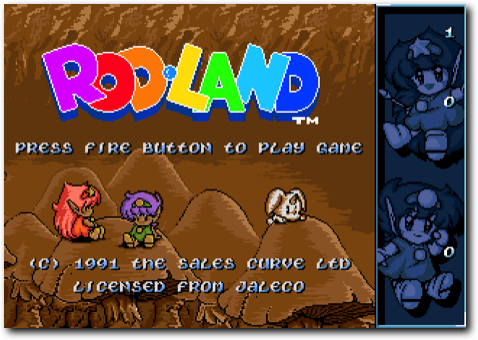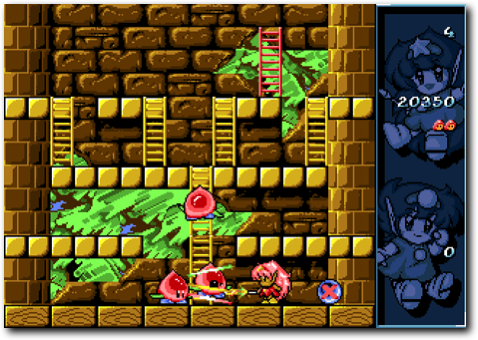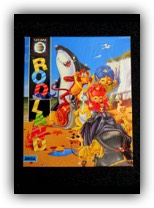Over the years, I've amassed a rather large collection of retro computer systems, game consoles, games and more. The Retro Reviews will feature my personal take on some of these games, systems and consoles. After all, what good is a retro computer/game themed website without some stuff about the games we used to play back in the 80s and 90s?
The third game I'll be taking a look at is Rod-Land (also known as Rodland or Rod Land), a single screen platform game converted from the original arcade version by The Sales Curve and released on the Commodore Amiga in 1991.
The third game I'll be taking a look at is Rod-Land (also known as Rodland or Rod Land), a single screen platform game converted from the original arcade version by The Sales Curve and released on the Commodore Amiga in 1991.

Above: the title screen of Rod-Land.
show
show
show
show
show
show
Game
Rod-Land
System
Commodore Amiga
Year
1991
Region
PAL / NTSC-A
Players
1 or 2
Saving
Highscore only
Let's start by getting the obvious out of the way: Rod-Land is cute. It's very cute. Some might say it's sickeningly cute. It's also an extremely good game, which gets even better if you play with a friend. I can honestly say I feel it's one of the very best games you can get on the Amiga.
Though this should be enough information to go and get and then play Rod-Land right now, I figure it might be nice to write a few more words about the game. After all, this section is called Retro Reviews and not Retro Snippets!
In the game, you play a pink-haired fairy called Rit (if you have a friend, he or she can join in and play a blue-haired fairy called Tam) on a serious quest: your mom has been kidnapped by a monster and taken atop the Maboots tower and you're going to rescue her. Being an Arcade classic, this is also pretty much the entire plot.
After all, who needs exposition and character building when you can fight monsters using a magic rod to rescue your mom?
Rescuing your mom involves clearing (single screen) level after level of monsters. You use the magic rod to bash trap them in some sort of magic fairy forcefield and then, in a very un-fairy kind of way, bash them over the head repeatedly until they die.
When they die the monsters drop tokens: items such as a rocket, piece of dynamite or bouncing squares of *doom* that explode on contact with a monster. All these items explode/launch/fire as soon as you pick them up. There's a whole bunch of these and it's quite fun to see what each of them does.
Clearing a level is as easy as killing all the enemies on the screen and then it's off to the next one. Every now and then you get to fight a boss monster (or monsters), which you kill by bashing them with your magic rod as often as possible.
Alternatively, you can choose to collect all the flowers that are growing in a level first. Doing so triggers the 'extra' game, where the monsters morph into odd looking things kind of resembling walking, red pieces of garlic with wings. Yeah...
Bashing the monsters now doesn't give you weapon tokens, but letter tokens you can use to spell 'extra'. Completing 'extra' gets you an extra life, so it might be better to collect all the flowers first. Naturally, this gives the monsters more opportunities to kill you, so it's more difficult.
Though this should be enough information to go and get and then play Rod-Land right now, I figure it might be nice to write a few more words about the game. After all, this section is called Retro Reviews and not Retro Snippets!
In the game, you play a pink-haired fairy called Rit (if you have a friend, he or she can join in and play a blue-haired fairy called Tam) on a serious quest: your mom has been kidnapped by a monster and taken atop the Maboots tower and you're going to rescue her. Being an Arcade classic, this is also pretty much the entire plot.
After all, who needs exposition and character building when you can fight monsters using a magic rod to rescue your mom?
Rescuing your mom involves clearing (single screen) level after level of monsters. You use the magic rod to bash trap them in some sort of magic fairy forcefield and then, in a very un-fairy kind of way, bash them over the head repeatedly until they die.
When they die the monsters drop tokens: items such as a rocket, piece of dynamite or bouncing squares of *doom* that explode on contact with a monster. All these items explode/launch/fire as soon as you pick them up. There's a whole bunch of these and it's quite fun to see what each of them does.
Clearing a level is as easy as killing all the enemies on the screen and then it's off to the next one. Every now and then you get to fight a boss monster (or monsters), which you kill by bashing them with your magic rod as often as possible.
Alternatively, you can choose to collect all the flowers that are growing in a level first. Doing so triggers the 'extra' game, where the monsters morph into odd looking things kind of resembling walking, red pieces of garlic with wings. Yeah...
Bashing the monsters now doesn't give you weapon tokens, but letter tokens you can use to spell 'extra'. Completing 'extra' gets you an extra life, so it might be better to collect all the flowers first. Naturally, this gives the monsters more opportunities to kill you, so it's more difficult.
Above: my video review of Rod-Land on the Commodore Amiga
Monsters are not particularly bright, but they do follow you about and there tends to be a lack of room to manoeuvre. There are also platforms which you can't easily reach, especially since you can't jump. To help fix that problem, both Tam and Rit have an additional tool in their arsenal: a magic ladder they can place on the screen, adding a way to get height and getting out of the way of the monsters.
Using the ladder effectively and knowing when you can best whack monsters with your magical rod is a key strategy here. The game can get quite hectic, especially with two players - in an ingenious move, the game lets you trap/hit each other with the rod as well. You can't kill the other player, but you can push him or her to their doom and this inevitably leads to great gaming moments. Or, if you just got pushed into that crying shark over there, a 'slight need' to take revenge!
One of the things that makes Rod-Land great is that it is almost perfectly tuned: the game starts of easy enough to be fun for new players, but hard enough so you're not immediately bored when you've played it before. Then, the difficulty slowly goes up until the whole then gets rather hectic. However, and this is where the one of the parts of the greatness of the game's design starts showing - it never actually gets so hard as to become unfair.
It's much the same with the weapon power ups: they are tuned just right, you want to get to use them - but doing so will mean less monsters to turn into the 'extra' tokens later on. In essence the game forces you to choose between having an easier time of the levels or to have more lives to keep playing.
Sounds simple enough to think up, but all this is also combined with well picked moments to introduce new monsters with new abilities to counter and fun boss encounters. Add to this the well timed addition of balloons, teleporter doorways and moving spiked balls and it all starts to adds up to a game that pretty much sums up why single-screen arcade games can be such great fun to play.
The great design doesn't stop at the single player game. The two player mechanics are, again, very well done. You're almost always better of by working together. On the other hand, pushing your friend into that monster over there so you get to pick up that last 'extra' token you need or even just to distract some of the trickier monsters for a while, can also be a good tactic. Just not so much for your friend!
Using the ladder effectively and knowing when you can best whack monsters with your magical rod is a key strategy here. The game can get quite hectic, especially with two players - in an ingenious move, the game lets you trap/hit each other with the rod as well. You can't kill the other player, but you can push him or her to their doom and this inevitably leads to great gaming moments. Or, if you just got pushed into that crying shark over there, a 'slight need' to take revenge!
One of the things that makes Rod-Land great is that it is almost perfectly tuned: the game starts of easy enough to be fun for new players, but hard enough so you're not immediately bored when you've played it before. Then, the difficulty slowly goes up until the whole then gets rather hectic. However, and this is where the one of the parts of the greatness of the game's design starts showing - it never actually gets so hard as to become unfair.
It's much the same with the weapon power ups: they are tuned just right, you want to get to use them - but doing so will mean less monsters to turn into the 'extra' tokens later on. In essence the game forces you to choose between having an easier time of the levels or to have more lives to keep playing.
Sounds simple enough to think up, but all this is also combined with well picked moments to introduce new monsters with new abilities to counter and fun boss encounters. Add to this the well timed addition of balloons, teleporter doorways and moving spiked balls and it all starts to adds up to a game that pretty much sums up why single-screen arcade games can be such great fun to play.
The great design doesn't stop at the single player game. The two player mechanics are, again, very well done. You're almost always better of by working together. On the other hand, pushing your friend into that monster over there so you get to pick up that last 'extra' token you need or even just to distract some of the trickier monsters for a while, can also be a good tactic. Just not so much for your friend!

Above: gameplay in Rod-Land involves bashing monsters over their heads.
As you can tell by now, I really, really like this game. So, how does it fare in the presentation, controls, graphics and sound departments?
Well, presentation is pretty much standard for 16-bit games like these: there is a title screen, some nicely drawn still screens to tell the story and high scores get saved to disk (but can be reset later if desired). There is no password system or in game saving, but then - the arcade version didn't offer these things either and you can complete the game in a single sitting anyway (if you're good enough). Nothing outstanding then, but nothing substandard either.
As an added bonus, the game runs on any amiga with 512Kb (or more) of memory and only rarely needs to load in new data as you're playing.
The game controls well and precise, with a good responsiveness to your actions. This extends to use of the ladder, which is intuitive and never slows down the action. It's one of those games where you can really only fault yourself when you manage to screw up, which is a good hallmark of well made game controls.
Graphics are incredibly cute and resemble a Japanese anime (which, considering the game is originally from Japan is probably not too surprising). They are colourful, well animated and there is good variety in monsters and backgrounds. As you'd expect from a single screen game on the Amiga, the performance of the game is great - there is no slowdown or sprite flicker whatsoever - even the bosses never slow down.
Sonically, the game presents some nice, fittingly cute tunes and well designed sound effects. Samples are clear and instruments have a nice clarity to them. The quality of the samples is certainly above the average for Amiga games, especially considering the relative large quantity of different sounds.
What I especially like is the way the sound effects and music combine. In most Amiga games you clearly notice when sound effects cut out the music (the Amiga only has four voices to play sounds on, so music and sound effects tend to get in each others way), but this game manages to deal with this problem better than most. You only really start noting the sound effects cutting out voices in the music if it gets busy, normally you don't really notice.
In conclusion, this game is great fun and comes highly recommended. Now excuse me, I've got some snakes-with-unicorn-horns to bash!
Well, presentation is pretty much standard for 16-bit games like these: there is a title screen, some nicely drawn still screens to tell the story and high scores get saved to disk (but can be reset later if desired). There is no password system or in game saving, but then - the arcade version didn't offer these things either and you can complete the game in a single sitting anyway (if you're good enough). Nothing outstanding then, but nothing substandard either.
As an added bonus, the game runs on any amiga with 512Kb (or more) of memory and only rarely needs to load in new data as you're playing.
The game controls well and precise, with a good responsiveness to your actions. This extends to use of the ladder, which is intuitive and never slows down the action. It's one of those games where you can really only fault yourself when you manage to screw up, which is a good hallmark of well made game controls.
Graphics are incredibly cute and resemble a Japanese anime (which, considering the game is originally from Japan is probably not too surprising). They are colourful, well animated and there is good variety in monsters and backgrounds. As you'd expect from a single screen game on the Amiga, the performance of the game is great - there is no slowdown or sprite flicker whatsoever - even the bosses never slow down.
Sonically, the game presents some nice, fittingly cute tunes and well designed sound effects. Samples are clear and instruments have a nice clarity to them. The quality of the samples is certainly above the average for Amiga games, especially considering the relative large quantity of different sounds.
What I especially like is the way the sound effects and music combine. In most Amiga games you clearly notice when sound effects cut out the music (the Amiga only has four voices to play sounds on, so music and sound effects tend to get in each others way), but this game manages to deal with this problem better than most. You only really start noting the sound effects cutting out voices in the music if it gets busy, normally you don't really notice.
In conclusion, this game is great fun and comes highly recommended. Now excuse me, I've got some snakes-with-unicorn-horns to bash!
show
show
Conclusion & Rating
show


show
show
show
show
show
Graphics
Colourful title screen and nicely drawn cutscene. Cute, well animated and detailed in game graphics with no hint of slowdown anywhere.
Sound
Fitting, well made tunes and good sound effects. High quality samples throughout. Handles combing sound effects and music very well.
Controls
The game controls well and precise, controlling the player sprite feels very natural.
Personal take
This is one of my absolute favorite games on the Amiga and one that I keep playing from time to time. I'd say every Amiga owner should at least try this one. It's great!
Overall rating
9 / 10